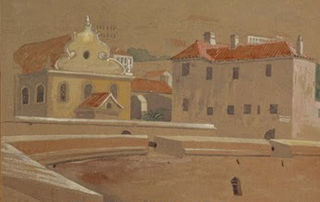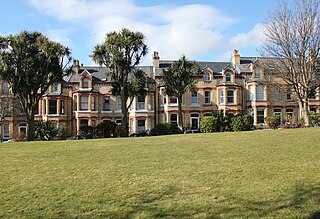
| Part of a series on the |
| Culture of the Isle of Man |
|---|
 |
| History |
| People |
| Languages |
| Mythology |
| Cuisine |
| Festivals |
| Religion |
| Literature |
| Music |
Media |
| Sport |
The history of the Jews in the Isle of Man goes back to at least the early 19th century.

| Part of a series on |
| Jews and Judaism |
|---|
| Part of a series on the |
| Culture of the Isle of Man |
|---|
 |
| History |
| People |
| Languages |
| Mythology |
| Cuisine |
| Festivals |
| Religion |
| Literature |
| Music |
| Sport |
The history of the Jews in the Isle of Man goes back to at least the early 19th century.
The Isle of Man (Manx : Mannin [ˈmanɪnʲ] , also Ellan Vannin [ˈɛlʲanˈvanɪnʲ] ), sometimes referred to simply as Mann /mæn/ , is a self-governing British Crown dependency in the Irish Sea between Great Britain and Ireland. The head of state, King Charles III, holds the title of Lord of Mann and is represented by a lieutenant governor. Defence is the responsibility of the United Kingdom.
There is a small Jewish community with the older congregational name of Isle of Man Hebrew Congregation now known as Manx Hebrew Congregation, [1] [2] without a synagogue or rabbi in the capital and largest town, Douglas. [3] There is a Jewish cemetery on the island. [4]
Various reports and advertisements about the Jews on the Isle of Man have appeared in the English press going back about a hundred years. [5] A 2016 report in The Jewish Chronicle stated that there were about 200 Jews on the island but they were not religious and mostly intermarried. [6]
Jews were interned on the Isle of Man during both World Wars as 'enemy aliens'. During World War I it was German Jewish prisoners of war and in World War II it was Jewish refugees fleeing Germany and Austria. [7]
In 1914 the British Government passed the Aliens Restriction Act. Citizens of Germany and the Austro-Hungarian Empire who were living in, or even only visiting the UK, were designated as possible "Enemy Aliens". Men of fighting age were interned for the whole duration of the war in special camps for civilian detainees. Camps were created at sites across the UK. As the war progressed, Prisoners of War were also put into the camps in London, The Isle of Man and Lofthouse Park. Over 32,000 civilian men were interned for some or all of the war. The Jewish Chronicle has archive evidence of the role that local British Jewish communities took on in support of some of the interned. [8]
During World War II, to escape the Holocaust some sources state that there were about 1,500 German-Jewish civilian internees, whose spiritual and material welfare was supervised by the British Chief Rabbi's "Religious Emergency Council". Other sources state that it is estimated that about 2,000 to 3,000 people, mostly Jews, were interned on the Isle of Man during World War II as 'enemy aliens', [9] with frequent visits by Rabbi Dr. Solomon Schonfeld, who inspected internee camps on behalf of the Council. A writer for The Jewish Chronicle wrote in November 1940:
Women and children internees were mostly housed in the areas of Port Erin and Port St Mary. [11]
Nazis and Jews from Germany initially shared internment facilities. [12] [13]
The BBC reported in 2016 on the background to this saga, that at the start of World War II there were around 80,000 people in Britain who were considered potential "enemy aliens". [14] The British government was afraid of spies and those who might assist the Nazis. In that light, the Isle of Man was chosen to accommodate people at camps in the towns of Douglas (see Hutchinson Internment Camp), Ramsey (see Mooragh Internment Camp) and Peel. The BBC report goes on to state that "political prisoners were detained in high security camps, but most internees - including many Jewish refugees - were free to go shopping, swim in the sea and attend classes. A few months later a mixed camp [for married couples] was established in Rushen." Eventually the Jewish prisoners were released and some men given the option of joining the British armed forces. [15] Reports of the time record that by August 1940, there were in total around 14,000 prisoners held on the Isle of Man, with thousands more transported to internment camps in Canada and Australia. [16]
At the Hutchinson Internment Camp in Douglas, numbers fell from September 1940 when the internees who posed no threat to Britain began to be released. [17] This was particularly marked in Hutchinson Camp, where there was an unusually high proportion of Jewish and anti-Nazi internees. [18] The camp closed during March 1944, when its 228 inmates transferred to Peveril Internment Camp in Peel in order to clear Hutchinson Camp ready for use as a prisoner of war camp. [19]
In 2001 the Jewish community on the Isle of Man instituted its own Holocaust Memorial Day that is commemorated annually on or around International Holocaust Remembrance Day. [20]
Gerhard Bersu was a German archaeologist who excavated widely across Europe. He was forced into exile from Germany in 1937 due to anti-Semitic laws in pre-war Nazi Germany. He was interned on the Isle of Man during World War II where he made several significant archaeological discoveries such as the Viking boat burial at Balladoole.

Tatura is a town in the Goulburn Valley region of Victoria, Australia, and is situated within the City of Greater Shepparton local government area, 167 kilometres (104 mi) north of the state capital (Melbourne) and 18 kilometres (11 mi) west of the regional centre of Shepparton. At the 2021 census, Tatura had a population of 4,955.

The Ukrainian Canadian internment was part of the confinement of "enemy aliens" in Canada during and for two years after the end of the First World War. It lasted from 1914 to 1920, under the terms of the War Measures Act.
In customary international law, an enemy alien is any native, citizen, denizen or subject of any foreign nation or government with which a domestic nation or government is in conflict and who is liable to be apprehended, restrained, secured and removed. Usually, the countries are in a state of declared war.
Recorded Jewish history in the Philippines started during the Spanish period.

The Cyprus internment camps were camps maintained in Cyprus by the British government for the internment of Jews who had immigrated or attempted to immigrate to Mandatory Palestine in violation of British policy. There were a total of 12 camps, which operated from August 1946 to January 1949, and in total held 53,510 Jews.

Numerous internment camps and concentration camps were located in France before, during and after World War II. Beside the camps created during World War I to intern German, Austrian and Ottoman civilian prisoners, the Third Republic (1871–1940) opened various internment camps for the Spanish refugees fleeing the Spanish Civil War (1936–1939). Following the prohibition of the French Communist Party (PCF) by the government of Édouard Daladier, they were used to detain communist political prisoners. The Third Republic also interned German anti-Nazis.
Ferramonti di Tarsia, also known as Ferramonti, was an Italian internment camp used to intern political dissidents and ethnic minorities. It was located in the municipality of Tarsia, near Cosenza, in Calabria. It was the largest of the fifteen internment camps established by Benito Mussolini between June and September 1940. Over 3,800 Jews were imprisoned at the camp.

After Adolf Hitler came into power in 1933 and enacted policies that would culminate in the Holocaust, Jews began to escape German-occupied Europe and the United Kingdom was one of the destinations. Some came on transit visas, which meant that they stayed in Britain temporarily, while waiting to be accepted by another country. Others entered the country by having obtained employment or a guarantor, or via Kindertransport. There were about 70,000 Jewish refugees who were accepted into Britain by the start of World War II on 1 September 1939, and an additional 10,000 people who made it to Britain during the war.

The Camp de Rivesaltes, also known as Camp Joffre, was an internment and transit camp in the commune of Rivesaltes in the department of Pyrénées-Orientales of the French Southern Zone during World War Two. Between August 11 and October 20, 1942, 2,313 foreign Jews, including 209 children were transferred from Rivesaltes via the Drancy internment camp to the Nazi extermination camp Auschwitz, where they were murdered. Serge Klarsfeld described the camp as the Drancy of the Southern Zone.

George Kenner was a German artist. He made 110 paintings and drawings during the First World War while interned as a German civilian internee in Great Britain and the Isle of Man.

The four active synagogues of Gibraltar are colloquially known as the Great Synagogue, the Little Synagogue, the Flemish Synagogue, and the Abudarham Synagogue. The first synagogue established after the 1717 expulsion of Jews from Gibraltar, the Great Synagogue, was built on what is now known as Engineer Lane, and remains Gibraltar's principal synagogue. The Little Synagogue, founded in 1759 in Irish Town, was the result of the desire of Moroccan Jews for a less formal service. The lavish Flemish Synagogue was built at the turn of the nineteenth century on Line Wall Road, due to the request of some congregants for a return to more formal, Dutch customs. The last synagogue to be established in what is now the British overseas territory of Gibraltar, the Abudarham Synagogue, was founded in 1820 on Parliament Lane by recent Moroccan immigrants.

Werner van der Zyl was a rabbi in Berlin and in London, where he came in 1939 as a refugee rabbi from Germany. He was the prime mover and first director of studies of the Jewish Theological College of London. The college was inaugurated in 1956 and was renamed Leo Baeck College shortly afterwards at his suggestion.

Hutchinson Internment Camp was a World War II internment camp in Douglas, Isle of Man, particularly noted as "the artists' camp" due to the thriving artistic and intellectual life of its internees.

The history of the Jews in Jersey dates back to at least the 1790s. There was a community in Jersey from the 1840s. The Jersey Old Hebrew Congregation was founded in 1843 and closed around 1870.

Kingston upon Hull, on England's East Coast was, by 1750, a major point of entry into Britain for traders and migrants, second only to London for links to the continent. Around then, a few Jews from German and Dutch cities lodged and settled in Hull. Selling jewelry and dealing goods in the thriving port and market town, they maintained contacts with Europe, London, and many other – particularly Northern – towns. The small community produced its own institutions and leaders, which were tested by anti-Jewish sentiment, and later by an influx of East-European refugees.
The city of Leeds, in West Yorkshire, England has a Jewish community, where many notable people originated or settled. They have played a major part in the clothing trade, the business, professional and academic life of the City, and the wider world. The community numbers now less than 7,000 people.
{{cite web}}: |last1= has generic name (help)